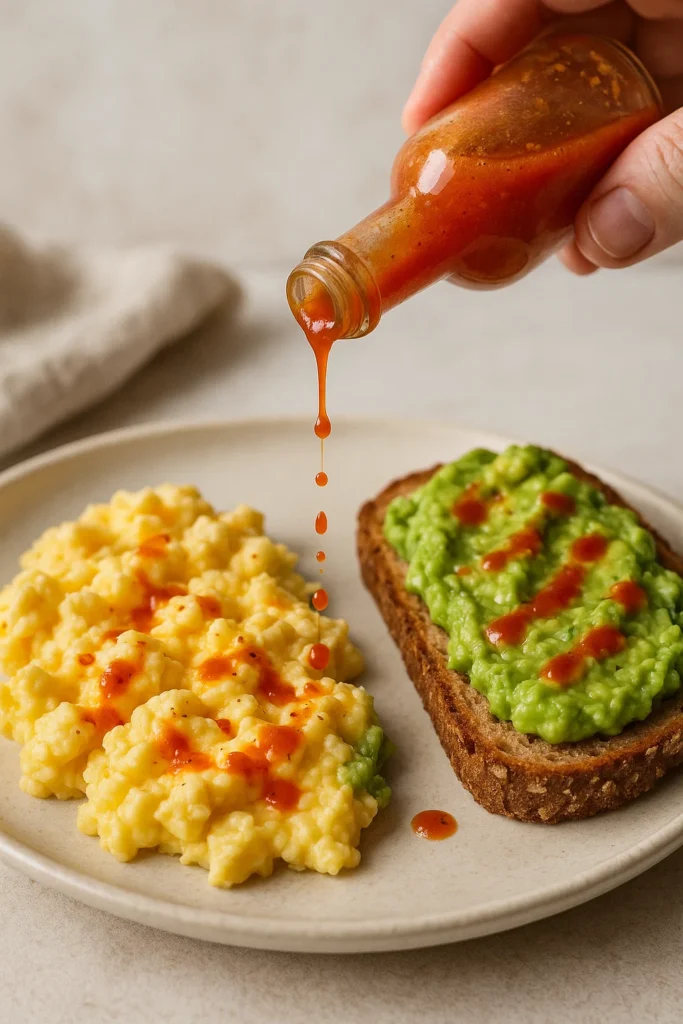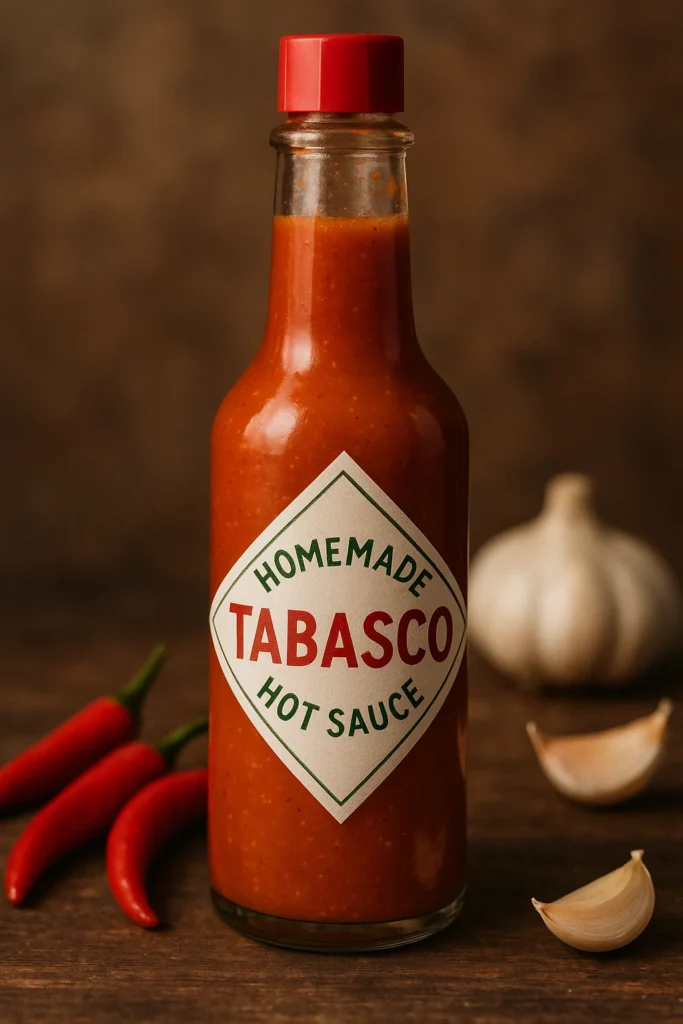There’s something thrilling about fermenting your own hot sauce, especially one inspired by a fiery American classic. I still remember the first time my grandmother brought back a small bottle of Tabasco from a Southern road trip. That deep red color and vinegary tang lit up our kitchen like fireworks. Inspired by that moment, I began making my own version—Homemade Tabasco Sauce—a tangy, fermented firecracker that has become a family favorite.
In this recipe, I’ll walk you through how to make homemade Tabasco sauce using fermented red chili peppers. The result is a bold, zippy condiment that’s perfect on eggs, tacos, grilled meats, or even a dash in your Bloody Mary. And the best part? It’s surprisingly simple and incredibly satisfying.
Why Make Your Own Homemade Tabasco Sauce?
Most store-bought hot sauces are loaded with preservatives or lack the deep umami richness of a slow-fermented blend. When you make it at home, you control the heat, the salt, the tang, and—most importantly—the flavor depth.
Benefits of Homemade Tabasco Sauce:
- Made with just three natural ingredients
- No additives or preservatives
- Richer flavor from natural fermentation
- Customizable heat level
- A perfect gift for spice lovers
Ingredients for Homemade Tabasco Sauce

Making this sauce is all about simplicity. You’ll need:
🔥 Ingredients (Yields about 1 cup)
- 200g fresh red Tabasco peppers (or cayenne if unavailable)
- 1 cup white vinegar (distilled or apple cider vinegar)
- 1 tablespoon sea salt (non-iodized)
Tip: Always wear gloves when handling hot peppers to avoid skin irritation.
Equipment You’ll Need
- A sterilized glass jar with lid (for fermentation)
- Blender or food processor
- Fine mesh strainer
- Small saucepan
- Glass bottle or jar for storage
Step-by-Step Instructions
🕒 Prep Time: 15 minutes
⏳ Fermentation Time: 2 to 4 weeks
🍳 Cook Time: 10 minutes
🧊 Total Time: 2 to 4 weeks + 25 minutes
Step 1: Prep the Peppers
Wash your red Tabasco peppers and remove the stems. You can leave the seeds in for extra heat. Roughly chop them.
Step 2: Salt and Store
Place chopped peppers in your sterilized jar. Sprinkle the sea salt over the top. Use a spoon or gloved hand to mash the peppers down slightly to release juices. Seal the jar loosely or cover with a fermentation lid to allow gases to escape.
Fermentation Tip: Store in a dark place at room temperature (ideally 65–75°F). Check the jar daily for bubbling and mold. Mold should be removed immediately, though white yeast (kahn yeast) is normal.
Step 3: Wait and Watch
Let the peppers ferment for at least 2 weeks—4 weeks is ideal for deeper flavor. The mixture will bubble and develop a pungent aroma.
Step 4: Blend and Strain
After fermentation, add the pepper mash and its liquid to a blender with 1 cup vinegar. Blend until smooth. Strain through a fine mesh sieve to remove solids if you prefer a thinner sauce.
Step 5: Simmer and Bottle
Pour the blended sauce into a saucepan. Simmer on low for about 5–10 minutes to mellow the flavor and ensure it’s safe for bottling. Let cool slightly and transfer to a glass bottle or jar.
Storage Tip: Store in the fridge for up to 6 months. The vinegar helps preserve it, but always check for freshness before use.
Flavor Variations to Try
Once you’ve mastered the basic homemade Tabasco sauce, experiment with fun twists:
- Garlic Tabasco: Add 1–2 garlic cloves during fermentation.
- Smoked Tabasco: Use smoked peppers like chipotle or add liquid smoke.
- Citrus Zing: Add a splash of lime juice before bottling for brightness.
What to Serve It With
This sauce is a kitchen MVP! Here are a few ways we love to use it:

- Breakfast: Drizzle on scrambled eggs or avocado toast
- Lunch: Spice up sandwiches, wraps, or tacos
- Dinner: Add heat to marinades, grilled chicken, or roasted veggies
- Drinks: A few dashes in a Bloody Mary or Michelada
Storage and Shelf Life
Your homemade Tabasco sauce will keep well refrigerated for up to 6 months. Shake it well before each use as natural separation is normal. The flavor will continue to evolve over time—many say it improves with age!
Tips for Perfect Fermentation
Getting fermentation right is key to the deep, umami-packed flavor of your homemade Tabasco sauce. Here are a few pro tips from my kitchen:
🌡️ Temperature Matters
Keep your jar in a cool, dark place at a steady room temperature (65–75°F). Avoid direct sunlight, which can kill the beneficial bacteria needed for fermentation.
💨 Gas Release is Crucial
Fermentation produces carbon dioxide. Either use a fermentation lid or remember to “burp” your jar daily (open the lid to release pressure).
🧂 Use the Right Salt
Non-iodized sea salt or kosher salt is best. Iodine and anti-caking agents can interfere with fermentation.
⛔ Mold vs Yeast
A little white film (kahn yeast) is okay—just skim it off. However, if you see fuzzy blue or green mold, discard the batch and start over.
Troubleshooting Your Homemade Tabasco Sauce
Too salty?
Try adding a bit more vinegar or a touch of sugar to balance it out.
Not spicy enough?
Use more peppers next time or add a hotter variety like habanero or Thai chili.
Too spicy?
Mix with milder ingredients like roasted red bell peppers to tone it down. Or serve with creamy foods that temper heat.
Too thick?
Add a splash of vinegar or filtered water until you reach your desired consistency.
A Brief History of Tabasco Sauce
Tabasco sauce traces its roots to the mid-1800s in Louisiana. It was invented by Edmund McIlhenny, who used Tabasco peppers, vinegar, and salt aged in oak barrels to create the original fiery condiment. It quickly became a Southern staple and is now a global icon of American cuisine.
By crafting your own homemade Tabasco-style sauce, you’re participating in a rich culinary legacy—one that blends the wisdom of fermentation with bold, unapologetic flavor.
FAQs About Homemade Tabasco Sauce
Can I use other types of peppers?
Yes! While traditional Tabasco uses Tabasco peppers, you can substitute with cayenne, bird’s eye chili, or Fresno peppers for similar heat and flavor.
Do I have to ferment it?
Fermentation creates deeper, more complex flavors. However, if you’re short on time, you can blend and simmer the ingredients without fermentation for a quicker version.
Is it safe to ferment at home?
Absolutely—just follow proper sanitation, use non-reactive containers, and monitor for mold. Vinegar added after fermentation helps further preserve the sauce.
Nutritional Info (Per Tablespoon, Approximate)
- Calories: 5
- Carbohydrates: 1g
- Fat: 0g
- Protein: 0g
- Sodium: 200mg
Note: Values vary based on pepper variety and vinegar used.
Final Thoughts

Making homemade Tabasco sauce is a simple yet deeply satisfying experience. It brings together tradition, creativity, and a touch of science. Whether you’re a seasoned fermenter or a curious beginner, this recipe is a great place to start.
So the next time you’re drizzling that tangy heat over your eggs or tacos, know that it’s not just sauce—it’s a labor of love bottled up.
Reader Engagement
Have you tried making your own hot sauce? I’d love to hear how your homemade Tabasco sauce turned out! Did you go mild or wild with the heat? Drop a comment below or tag me on Instagram—let’s talk hot sauce!



5 thoughts on “Homemade Tabasco Sauce – A Spicy Tradition from the South”